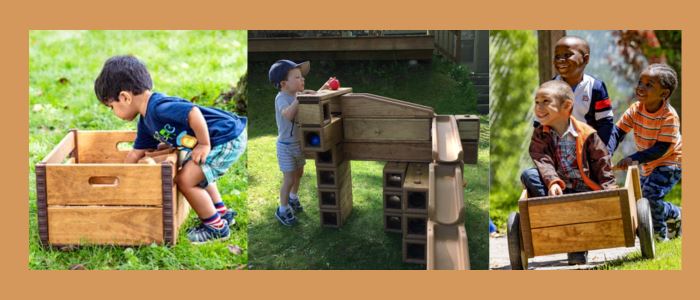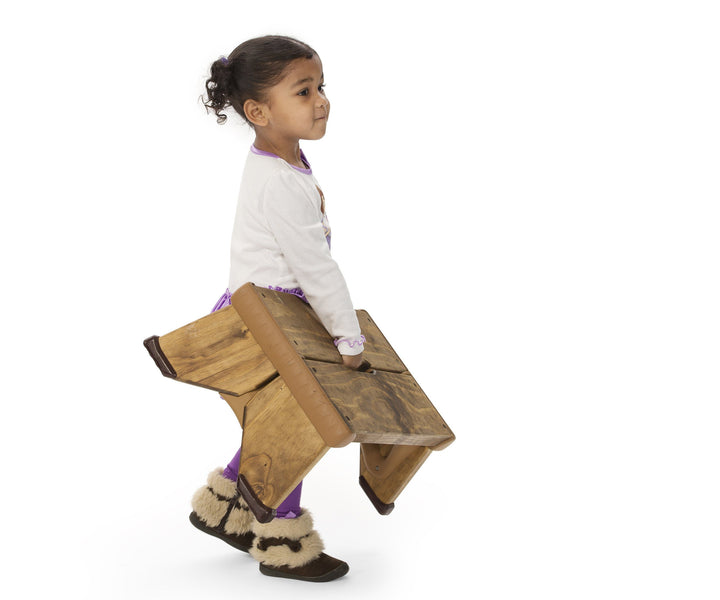Menu

Landscaping with raw unfinished lumber is a popular trend for early years outdoor play areas. Although a naturalized look is a refreshing alternative to steel and plastic play grounds, it can still limit the natural play impulses of children, described by Simon Nicholson in his Theory of Loose Parts Play.
To unlock natural play, not only should play resources be natural but they have to be open-ended and flexible. In this post, we’ll look at how open-ended Outlast outdoor play resources compliment research into children’s use of playground equipment and "Loose Parts" theory.
A five-year, multidisciplinary study of Vancouver childcare playgrounds* found that fixed play equipment – slides, climbers, etc. – were vacant a staggering 87% of the time that children were in the playgrounds for outdoor playtime.
Even when they did occupy the equipment, children used these fixed structures in their intended manner – eg. climbing, sliding etc. – only 3% of the playtime.
Of that 13% that they actually used the expensive fixed structures, they were more likely to sit underneath them as a cozy retreat then climb on top, slide down etc.

While replacing plastic and steel for wood creates a natural look, it doesn’t address the core problem.
Designed play yards with fixed natural elements -- boulders or logs too heavy to move, embedding vertical poles or burying stumps and disks -- do not engage children to create their own play environment.
The “Theory of Loose Parts Play” developed by architect Simon Nicholson in 1972, advocated for open ended large play resources such as stumps, and tree limbs even rubber pipes. Big objects, not fixed to the ground are a treasure trove of learning opportunities that trigger transporting impulses, engaging big muscle work in dramatic play and construction of structures, boundaries and home bases for games, etc.
Outlast Blocks are open-ended wood resources that engage all those natural play impulses while still being carefully engineered for durability and child safety. With planks, long log-like pieces, ramps and cubes, children can build and rebuild their own life-size play environments. With a unique knob and hole system and carefully proportioned pieces, solid satisfying structures promote cooperative full body play, engineering thinking, creativity and big muscle work.

And although Outlast Blocks help develop self-regulation skills and risky play they don’t have the risk of slivers or the worry of degradation (we talked about in this previous post, "Outdoor Classrooms, Blocks and the Sliver Dilemma").
Play spaces should incorporate living things, be sensitive to climate, and designed at a child's scale. By embracing loose parts play, imagination takes center stage, allowing children to shape their play experiences. These areas become spaces where children can engage in solo play or collaborate with peers, fostering social interaction and holistic development.





In conclusion, while incorporating natural elements into outdoor play areas is commendable, it is essential not to limit play potential by only having buried, cemented, or otherwise immovable structures.
By introducing flexible, life size, durable Outlast play resources, children create their own play environments. Outlast harnesses and inspires the impulse in children to freely manipulating their surroundings, as described in Nicholson’s Theory of Loose Parts, to spark imagination, and encourage cooperation and big muscle exercise.
*from The 7C’s: an informational guide to young children’s outdoor play spaces, Consortium for Health, Intervention, Learning and Development (CHILD), 2007

Request your NEW 2024 Louise Kool Early Years catalogue, with new products and expanded categories!

Let us help you realize an inspiring learning environment with unmatched expertise and service.

We are here to help. From Budgeting to Room and Centre Planning we have the answers you're looking for.

If you have a questions regarding existing orders or quotes don't hesitate to contact us.
1-800-268-4011
service@louisekool.com

© 2025, Louise Kool & Galt Powered by Shopify
